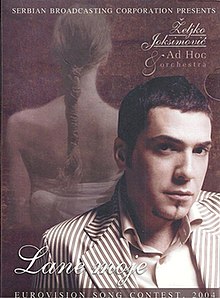Lane moje
"Lane moje" (Serbian Cyrillic: Лане моје, pronounced [lâne mǒje]; literally "My Fawn", figuratively "My Darling") is the name of the song performed by Serbian musician Željko Joksimović at the Eurovision Song Contest 2004 for Serbia and Montenegro, in which it finished second. Inspired by traditional Serbian music (also called ethno), in the style of a ballad, it won in the semi-finals but ultimately lost closely to Ukrainian "Wild Dances", finishing second scoring 263 points, becoming the first non-winning song in the contest, along with Greece's entry "Shake It", to score over 200 points. The song set a trend of world music strategy in the competition by the former Yugoslav republics.[1]
| "Lane moje" | |
|---|---|
 | |
| Single by Željko Joksimović | |
| Released | 2004 |
| Songwriter(s) |
|
| Eurovision Song Contest 2004 entry | |
| Country | |
| Artist(s) | |
| With | Ad Hoc Orchestra |
| Language | |
| Composer(s) | Željko Joksimović |
| Lyricist(s) | |
| Finals performance | |
| Semi-final result | 1st |
| Semi-final points | 263 |
| Final result | 2nd |
| Final points | 263 |
| Entry chronology | |
| "Zauvijek moja" (2005) ► | |
The song has become popular amongst many Eurovision fans and it is often rated as one of the best non-winning songs.[2][3][4]
Joksimović went on to compose Bosnia's 2006 entry, Serbia's 2008 entry, to host the 2008 Contest, to perform Serbia's 2012 entry and to compose Montenegro's 2015 entry.
Track list
- "Lane moje"
- "Good bye"
- "Lane moje (Instrumental version)"
- "Lane moje (Eastern mix by Alek)"
- "Lane moje (Trancefusion mix by Dream Team)"
Charts
| Chart (2004) | Peak position |
|---|---|
| Greek Single Charts[5] | 24 |
References
- Nutida musik. Vol. 49–50. International Society for Contemporary Music, Svenska sektionen. 2006. p. 34.
- ""Lane moje" - the best song in the history of Eurovision". RTS.
- "The Eurovision Song Contest: 10 of the best". The Guardian.
- "Wiwi Jury of the 2010s: Serbia's Željko Joksimovic with "Nije Ljubav Stvar"". Wiwibloggs. Retrieved 7 April 2020.
- "Greek Singles Charts Top 50 Singles". Archived from the original on 2004-09-08. Retrieved 2004-09-08.